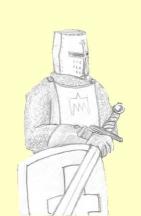 |
|||
 |
Were Medieval Knights bad or good?
There has been a long-standing debate about Medieval Knights. Were they chivalrous and gallant caretakers of their peasants? Or were they vicious and cruel thugs who ruled their people with an iron hand? The answer to that question is both! But I don’t mean at the same time. Medieval Knights changed over the course of centuries and this change was more than just in their combat techniques, tactics, weapons and armor. They also changed in their attitudes of how they handled their people and how they approached forming and maintaining their lands and kingdoms. The Early KnightsThe period we consider to be the Dark Ages, which started in the 5th century with the fall of Rome, was a very dark time for all of Europe. And it was also a very dark time for the reputation of the knight. Most of Europe was fragmented into pieces, trade and prosperity came to a halt, plague hit the continent and many invading armies came from both the north and the south. To make matters worse all of Europe was fighting within itself. Small kingdoms were pitted against each other in constant war that lasted centuries. This overall environment of difficulty, war and poverty was the breeding ground for knights that were cruel and unjust. It was a symptom of the times that the only code of the knight was the code of force. Force was the way that most of the continent acted. It was the predominant way someone could gain and control power, land, wealth and people. The Rise of ChristianityIn the 10th through 12th centuries the behavior of knights began to change. The Catholic Church was rising in power and it was exerting its power and tenets over people. In the early centuries many knights, kings and lords joined with the rising power of the church with their own agendas in mind, but the tenets of the religion in as far as treating people better began to make a foothold into the continent. The Launching of the CrusadesIn 1095 the first crusades were launched. This marked the end of the Dark Ages and the beginning of a new period of Medieval Europe. It began the process of bringing all of Europe together under one leadership. This brought to an end the centuries long warring between small lordships in Europe and this allowed the reestablishment of trade and the return of peace to the continent. It also firmly established the culture and beliefs of the Catholic Church into the social structure of the land. These beliefs included many things including the concepts of killing as a bad thing and that a person of privelege should treat the poor with dignity. Following the religion of Christianity became the most important aspect of a knight’s life. We can never really know for certain exactly how things were a thousand years ago. Every knight was surely different and to know whether a knight was villainous or chivalric we would have to look at each knight individually. But we do know that the early centuries of the Middle Ages were a difficult and barbaric time and knights were probably barbaric. And we do know that over the centuries the continent of Europe was transformed into a peaceful place with a religion to live by. And Knights followed this religion. Over these centuries chivaly and a code of conduct slowly evolved and took root in the culture of Europe, and of the knight.
Knights: In History and Legend The most comprehensive book on knights and knighthood available. The word "knight" conjures up images of gallant men in gleaming armor astride noble steeds, searching for foes to fight and fair maidens to rescue. In Knights the reality of knighthood is detailed, warts and all. This handsome reference tells the true story of these mounted warriors, who evolved from simple soldiers on horseback to defenders of the faith during the Crusades.
I have lots of interesting articles about knights, their weapons and their organizations right here: Articles about Knights
|

Custom Search
|
|
Copyright©2007-2014 Kalif Publishing - All Rights Reserved | sitemap | xml sitemap |
|||

